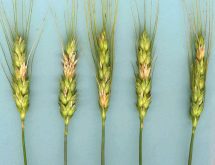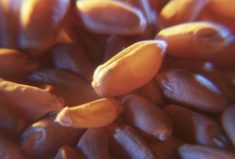“Timing is very important for optimum efficiency.”
– Pam De Rocquigny
Using several techniques to protect crops from fusarium head blight (FHB) is better than just one, but if the weather is right for the fungus disease, farmers’ best efforts will be in vain.
“You as producers can do everything in your power to mitigate that risk, but weather does play a huge role,” Pam de Rocquigny, Manitoba Agriculture, Food and Rural Initiatives’ (MAFRI) business development manager for feed grains, told farmers at Ag Days here Jan. 21.
Read Also

Mazergroup’s Bob Mazer dies
Mazergroup’s Bob Mazer, who helped grow his family’s company into a string of farm equipment dealerships and the main dealer for New Holland machinery in Saskatchewan and Manitoba, died July 6 from cancer.
“The management practices you use can minimize the impact of FHB in years of low disease pressure, but in years when there is high disease pressure, Mother Nature does usually tend to have the final say.
“Weather accounts for most of the yearly variation that we observe in FHB.”
FHB reduces yield and quality in durum, wheat, barley, oats and corn and can sometimes produce a toxin, DON (deoxynivalenol), that’s harmful to livestock and humans.
The best fix would be to plant fusarium-resistant crops, but there are none available. Only two varieties of Canada Western Red Spring wheat – 5602HR and Waskada – are rated as “good” for FHB tolerance, de Rocquigny said. All the registered Canada Western Amber durum wheats are rated “poor” or “very poor.”
Of the six registered Canada Western Red Winter wheats, three are rated as “very good,” two as “good,” and one as “fair.” (See Seed Manitoba 2009 for details.)
There are at least five measures farmers can employ, de Rocquigny said, to mitigate a moderate FHB outbreak: tillage practices, crop rotation, applying fungicides, seeding rate and crop selection.
It’s counterintuitive, but FHB infections are highest in minimum-till fields and lower under conventional or no till.
Ideally there will be a one-year break, preferably two, between wheat crops in the same field. However, infection can still blow in from nearby wheat fields or grassed areas.
Three fungicides – Bravo, Folicur and Proline – are registered for FHB control but they only “suppress” the disease.
“Timing is very important for optimum efficiency,” de Rocquigny said. To get the best protection the fungicides must be applied when wheat is at 50 to 75 per cent anthesis. Depending on the weather, wheat flowering can occur over as few as five days or take more than a week.
“It’s important (close to flowering time) to be out there looking at your crop because conditions can change very quickly,” she said.
To promote more even flowering de Rocquigny recommended a higher seeding rate to reduce tillering.
Some varieties have slightly better tolerance to FHB than others. Also, because FHB infection occurs during flowering, growing varieties that flower at different times can spread the risk. Staggering wheat seeding can accomplish the same thing, although de Rocquigny admitted few farmers will do it because they don’t have time.
Crops are especially vulnerable to infection at flowering but the disease can infect wheat right up to the hard dough stage. Before a crop can be infected, however, the inoculum must be present and the weather warm and moist.



















